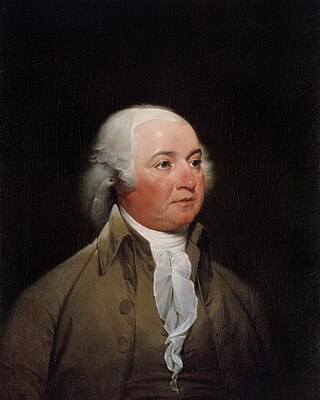Related Research Articles

The 1792 United States presidential election was the second quadrennial presidential election. It was held from Friday, November 2, to Wednesday, December 5, 1792. Incumbent President George Washington was elected to a second term by a unanimous vote in the electoral college, while John Adams was re-elected as vice president. Washington was essentially unopposed, but Adams faced a competitive re-election against Governor George Clinton of New York.

The 1796 United States presidential election was the third quadrennial presidential election of the United States. It was held from Friday, November 4 to Wednesday, December 7, 1796. It was the first contested American presidential election, the first presidential election in which political parties played a dominant role, and the only presidential election in which a president and vice president were elected from opposing tickets. Incumbent vice president John Adams of the Federalist Party defeated former secretary of state Thomas Jefferson of the Democratic-Republican Party.

The 1832 United States presidential election was the 12th quadrennial presidential election, held from Friday, November 2 to Wednesday, December 5, 1832. Incumbent president Andrew Jackson, candidate of the Democratic Party, defeated Henry Clay, candidate of the National Republican Party.

In the United States, the Electoral College is the group of presidential electors required by the Constitution to form every four years for the sole purpose of voting for the president and vice president. Each state appoints electors under the methods described by its legislature, equal in number to its congressional delegation. The federal District of Columbia also has 3 electors under an amendment adopted in 1961. Federal office holders, including senators and representatives, cannot be electors. Of the current 538 electors, a simple majority of 270 or more electoral votes is required to elect the president and vice president. If no candidate achieves a majority there, a contingent election is held by the House of Representatives to elect the president and by the Senate to elect the vice president.

In the United States Electoral College, a faithless elector is an elector who does not vote for the candidates for U.S. President and U.S. Vice President for whom the elector had pledged to vote, and instead votes for another person for one or both offices or abstains from voting. As part of United States presidential elections, each state selects the method by which its electors are to be selected, which in modern times has been based on a popular vote in most states, and generally requires its electors to have pledged to vote for the candidates of their party if appointed. A pledged elector is only considered a faithless elector by breaking their pledge; unpledged electors have no pledge to break. The consequences of an elector voting in a way inconsistent with their pledge vary from state to state.

The 1824 United States House of Representatives elections in New York were held from November 1 to 3, 1824, to elect 34 U.S. Representatives to represent the State of New York in the United States House of Representatives of the 19th United States Congress.

The 1792 United States presidential election in Pennsylvania took place as part of the 1792 United States presidential election. Pennsylvania voters chose 15 members of the Electoral College, each of whom, under the provisions of the Constitution prior to the passage of the Twelfth Amendment, cast two votes for President.

The 1832 United States presidential election in Delaware took place between November 2 and December 5, 1832, as part of the 1832 United States presidential election. Voters chose three representatives, or electors to the Electoral College, who voted for President and Vice President.

The 1832 United States presidential election in Maryland took place between November 2 and December 5, 1832, as part of the 1832 United States presidential election. Voters chose 10 representatives, or electors to the Electoral College, who voted for President and Vice President.

Following is a table of United States presidential elections in Delaware, ordered by year. Since its admission to statehood in 1787, Delaware has participated in every U.S. presidential election.

Following is a table of United States presidential elections in South Carolina, ordered by year. Since its admission to statehood in 1788, South Carolina has participated in every U.S. presidential election except the election of 1864 during the American Civil War, when the state had seceded to join the Confederacy.

Following is a table of United States presidential elections in Vermont, ordered by year. Since its admission to statehood in 1791, Vermont has participated in every U.S. presidential election.

The 1792 United States presidential election in New York took place between November 2 and December 5, 1792 as part of the 1792 United States presidential election. The New York State Legislature chose 12 members of the Electoral College, each of whom, under the provisions of the Constitution prior to the passage of the Twelfth Amendment, cast 2 votes for President.

In analysis of United States presidential elections, the phrase "tipping-point state" is a term that some political commentators use to describe the first state on a chart of high-margin victories to low-margin victories that gives the winning candidate a majority of electoral votes in the Electoral College.

The 1792 United States presidential election in Maryland took place on an unknown date in 1792, as part of the 1792 presidential election. Voters chose eight representatives, or electors to the Electoral College, who voted for President and Vice President.
The 1792 United States presidential election in Massachusetts took place between November 2 and December 5, 1792, as part of the 1792 United States presidential election. In this election, two Congressional districts chose five electors each, the remaining two districts chose three electors. Each elector chosen by majority vote of voters in Congressional district. If an insufficient number of electors are chosen by majority vote from a Congressional district, remaining electors would be appointed by the state legislature.
References
- ↑ Based on the majority vote and majority deisgnation of electors in elections where the state awarded electors to multiple candidates.
- 1 2 3 4 Wallace, 1968.
- 1 2 3 4 Thurmond, 1948.
- 1 2 3 4 5 6 T. Roosevelt, 1912.
- 1 2 3 4 5 Weaver, 1892.
- 1 2 3 4 5 6 7 8 9 10 Washington, 1788-89, 1792.
- 1 2 3 Bell, 1860.
- 1 2 3 4 5 Washington, 1792.
- ↑ Fillmore, 1856.
- ↑ Byrd, 1960.
- ↑ Floyd, 1832.
- ↑ Wirt, 1832.
- ↑ La Follette, 1924.